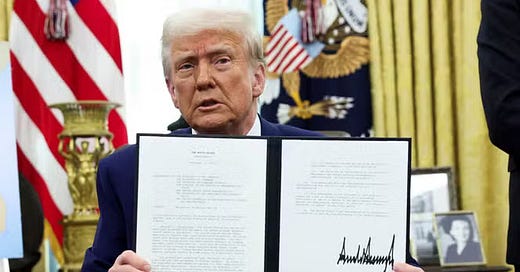How to Secure Your Projects Against Tariffs
Here’s your free checklist to avoid expensive tariff mistakes.
👋 Hey, Kyle here! Welcome to The Influential Project Manager, a weekly newsletter covering the essentials of successful project leadership.
Today’s Overview:
Tariffs are here, and they’re driving up material costs, disrupting supply chains, and putting massive pressure on project budgets.
Prices for steel, aluminum, and essential construction materials have already spiked. Contractors who don’t act now risk budget overruns, schedule delays, and lost profits. How do you protect your project from these tariffs that could leave you eating the bill?
This guide gives you a simple, actionable game plan—including contract must-haves, risk mitigation strategies, and a free Tariff Preparedness Checklist to safeguard your projects before it’s too late.
🖥️ UPCOMING SPECIAL WEBINAR
Presented by Document Crunch.
📅 Thursday, March 13, 2025
⏰ 2 p.m. ET / 11 a.m. PT
With the recent implementation of government tariffs, construction leaders face increased risks — from material price spikes to supply chain delays and workforce shortages. Are your contracts built to protect your projects?
Join us for an exclusive webinar with AGC Smartbrief where legal and industry experts will break down what you need to know:
Contract Essentials – Attorneys Kyle Dungca & Matt Porter from Document Crunch will reveal key clauses to watch for
Real-World Insights – Coe Norton, Senior Project Manager at Dant Clayton, shares firsthand experiences on navigating risks
Actionable Strategies – Learn how to protect your projects and mitigate financial impact
Don’t let shifting policies catch you off guard! Register now to gain expert guidance and take control of your contracts.
🛡️ How to Secure Your Project Against Tariffs
Filed under: Construction, Project Management
The tariff storm is here. Are you ready?
After months of speculation, tariffs are now a reality. And if it’s not on your risk register yet—add it now. Contractors are now navigating the real impact of escalating trade wars.
The U.S. has enacted a 25% tariff on imports from Mexico and Canada and an additional 20% tariff on Chinese goods. These policies are disrupting supply chains, increasing material costs, and squeezing project budgets.
The construction industry has been anticipating this for months. Prices for key materials have already jumped as contractors rushed to order supplies early. Now, the real test begins.
Waiting costs money. The key to protecting your projects is getting ahead of the impact.
In this guide, you'll learn:
What’s really happening with tariffs and how they're impacting construction.
Key contract protections every project leader must review now.
Practical steps to manage risk, control costs, and stay on track.
And to make this actionable, I’m sharing a FREE Tariff Preparedness Checklist—a simple tool to assess your project’s exposure and safeguard your contracts.
Let’s get into it.
What’s Really Happening?
Tariffs and fluctuating energy prices are reshaping how projects are planned and executed. Some developers are pausing projects due to escalating costs, while others see opportunities in the shifting landscape.
Rising Costs:
Material prices jumped 1.4% in January—the biggest spike in two years.
Steel & aluminum: 10-25% price hikes, extended lead times.
Electrical & HVAC: 15%+ increases, with critical component shortages.
Drywall & insulation: Up 5-20%, driven by energy costs.
Project Delays:
Supply chain gaps: Some HVAC systems & specialty materials already face 1-2 week delays.
Freight costs: Fluctuating due to tariff-related pressures. Expect continued volatility.
Regional strain: The Southwest & Southeast face the worst shortages, fueling wage spikes & scheduling challenges.
The Fallout:
Project budgets are under severe pressure.
Some planned projects will need revised cost estimates.
Skilled labor shortages are getting worse, pushing wages even higher.
Bottom line? If you don’t take action, tariffs will eat into your margins. The time to prepare is now.
How Do You Protect Your Project?
The impact of new or increased tariffs can escalate quickly. Scenario-based planning is critical to staying ahead.
There are four key steps every project leader should take today to protect their projects, manage costs, and avoid financial losses.
Step 1: Know Your Contracts (Inside & Out)
First things first—pull out your contracts. Every single one for every active project.
Yes, it’s tedious. Yes, it’s necessary. This could save you thousands (or even millions) in unexpected costs.
Here's what you're looking for:
Price escalation clauses: Does your contract allow for material cost adjustments?
Notice requirements: Do you need to formally notify the owner within a specific time frame?
Time limits on change orders: Are there strict time limits for submitting cost-related adjustments?
Force majeure provisions: Does your contract include trade wars or tariffs under excusable delays?
Documentation requirements: What proof do you need to submit a valid claim for tariff-related increases?
Action item: Create a simple spreadsheet for each project to track these details. Spending a little time now can save you a lot later.
Step 2: Notify Stakeholders & Protect Your Position
Once you understand your contractual rights, sound the alarm—professionally.
This isn’t about causing panic. It’s about protecting your company and keeping stakeholders informed.
Here's your notification checklist:
Send formal written notice to owners and upstream contractors.
Reference contract provisions (price escalation, change in law, force majeure, etc.).
Keep the tone professional but firm—clarify potential impacts.
Document delivery & receipt of all notices.
Follow up verbal discussions with email summaries.
Note: Many contracts require written notice within 5-7 days of learning about a cost impact. If you miss that window, you may lose your right to compensation. Don’t make that mistake.
Step 3: Document Everything (And I Mean Everything)
You’ll need hard evidence to support any cost adjustments or claims. Start gathering proof now:
Current material prices: Get updated supplier quotes
Supplier notifications: Any letters warning of cost increases.
Industry reports: Proof of rising prices & supply chain disruptions.
Historical price data: Show pre-tariff trends
Correspondence with vendors: Emails, purchase orders, invoices.
Action item: Centralize this information in a shared system. You’ll need it for:
Change order requests
Claims documentation
Potential legal disputes
Project close-out negotiations
No documentation = no compensation.
Step 4: Mitigation Strategies
The prior steps focused on defense—understanding contracts, notifying stakeholders, and documenting impacts. Now, let’s talk offense—proactive strategies to keep your project on track despite tariffs.
Early Procurement & Bulk Purchasing: Lock in prices now for high-risk materials like steel, aluminum, and electrical components.
Alternative Sourcing & Domestic Suppliers: Diversify your supplier network and explore U.S.-based or alternative material options to lower cost volatility.
Prefabrication & Modular Construction: Shift to off-site fabrication for HVAC, electrical, and structural components to minimize labor needs, avoid schedule delays, and control costs.
Buying Direct: Think about procuring HVAC & electrical equipment directly to bypass supply chain bottlenecks & subcontractor markups.
Proactive leaders don’t just react—they adapt.
✅ Your Tariff Preparedness Checklist
Are your contracts built to protect your projects?
Use this free checklist to assess your risk exposure and identify gaps before tariffs impact your bottom line.
Material Price Escalation: Determine whether the contract includes a material escalation clause that allows the contractor to recover increased material costs due to tariffs.
Does the contract explicitly allow for price adjustments due to increased material costs from tariffs?
Changes in Laws & Regulations: Determine whether the contract allows for adjustments in cost or schedule if new laws, tariffs, or government regulations impact the project.
Does the contract provide relief (such as additional time or compensation) if new laws, regulations, or tariffs increase costs or delay work?
Delays & Force Majeure: Determine whether the contract allows for schedule extensions due to tariffs, supply chain disruptions, or trade restrictions.
Is there a force majeure clause that includes tariffs, supply chain disruptions, or government-imposed trade restrictions as excusable delays?
Change Orders for Tariff-Related Impacts: Determine whether the contract contains any limitations on submitting change orders for tariff-related cost or schedule impacts..
Is the contractor entitled to a change order for impacts due to tariffs? (i.e., do any limitations on tariff-related change orders exist?)
What is the change order process? Are there any special considerations for tariff-related change orders?
Is the contractor entitled to markup on change orders related to tariffs?
Does the contractor have the right to stop work in the event of a disputed change order?
Preservation of Rights for Additional Remedies: Identify the required steps (e.g., written notice, claim deadlines) to secure additional compensation or time extensions due to tariffs.
Does the contract clearly state the steps required to preserve your right to additional compensation or time extensions, such as written notices, deadlines for claims, and specific documentation requirements?
Contingency: Determine whether the contractor is entitled to use contingency funds to cover increases in costs of materials due to tariffs.
Can the contractor use contingency to cover the increased cost of materials due to tariffs?
Insurance & Bonds: Determine whether the contract requires additional insurance or bonding to protect against tariff-related price fluctuations.****
Does the contract require any specific insurance or bonding to protect against risks presented by tariffs?
Termination & Suspension Rights: Determine whether the contract allows you to suspend or terminate work without penalty if tariffs significantly increase project costs or delay the project schedule.
Does the contract allow you to terminate or suspend work if tariffs significantly increase material costs or delay the project schedule?
Dispute Resolution: Ensure the contract provides a fair dispute resolution process for addressing tariff-related impacts, such as mediation or arbitration.
Is there a defined process for resolving disputes related to tariff-driven cost increases (mediation, arbitration, litigation)? Is continued performance required in the event of a dispute?
This checklist will help you quickly spot vulnerabilities—and protect your project from tariff risks.
DOCUMENT CRUNCH
Where should contractors start?
Document Crunch’s new AI-powered Tariff Preparedness Tool helps contractors implement the above contract improvements in minutes. Here’s how:
Go to the Document Crunch website and sign up.
Give them your contract.
Get an AI-powered analysis against the latest tariff policies—at zero cost.
Implement the necessary risk management actions before it’s too late.
Not part of the Crunch Community yet? Try it today.
Until next week,
Kyle Nitchen

Whenever you're ready, there are 5 ways I can help you:
Get my first book! No Bullsh*t Project: A Project Manager’s Guide to Successful Project Leadership
Upgrade your scheduling software. Experience the future planning system for construction and real estate development. iPM subscribers get a 15% discount on the first year license.
Get my full toolbox (free). Access 30+ software and hardware tools I'm using today.
Learn Takt Planning. Elevate your skills as a scheduler, planner, and lean builder with the Takt Planning & Control online course. Use code "Influentialpmtakt" for 30% off.
Advertise in my newsletter. Put your brand in front of 6,400+ construction project managers, leaders, and execs. (Booked out 8 weeks)







Insightful. Thank you for sharing.